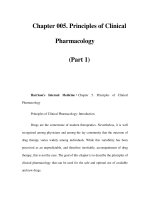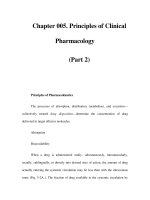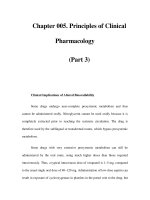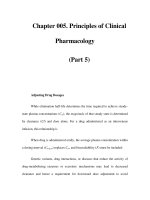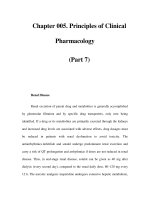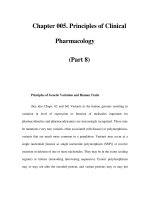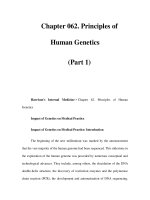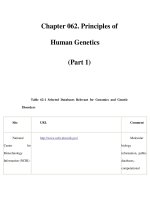Chapter 062. Principles of Human Genetics (Part 17) pdf
Bạn đang xem bản rút gọn của tài liệu. Xem và tải ngay bản đầy đủ của tài liệu tại đây (61.21 KB, 9 trang )
Chapter 062. Principles of
Human Genetics
(Part 17)
Genotypes describe the specific alleles at a particular locus. For example,
there are three common alleles (E2, E3, E4) of the apolipoprotein E (APOE) gene.
The genotype of an individual can therefore be described as APOE3/4 or APOE4/4
or any other variant. These designations indicate which alleles are present on the
two chromosomes in the APOE gene at locus 19q13.2. In other cases, the genotype
might be assigned arbitrary numbers (e.g., 1/2) or letters (e.g., B/b) to distinguish
different alleles.
A haplotype refers to a group of alleles that are closely linked together at a
genomic locus (Fig. 62-8). Haplotypes are useful for tracking the transmission of
genomic segments within families and for detecting evidence of genetic
recombination, if the crossover event occurs between the alleles (Fig. 62-3). As an
example, various alleles at the histocompatibility locus antigen (HLA) on
chromosome 6p are used to establish haplotypes associated with certain disease
states. For example, 21-hydroxylase deficiency, complement deficiency, and
hemochromatosis are each associated with specific HLA haplotypes. It is now
recognized that these genes lie in close vicinity to the HLA locus, which explains
why HLA associations were identified even before the disease genes were cloned
and localized. In other cases, specific HLA associations with diseases such as
ankylosing spondylitis (HLA-B27) or type 1 diabetes mellitus (HLA-DR4) reflect
the role of specific HLA allelic variants in susceptibility to these autoimmune
diseases. The recent characterization of common SNP haplotypes in four
populations from different parts of the world through the HapMap project is
providing a novel tool for association studies designed to detect genes involved in
the pathogenesis of complex disorders (Table 62-1). The presence or absence of
certain haplotypes may also become relevant for the customized choice of medical
therapies (pharmacogenomics) or for preventative strategies.
Allelic Heterogeneity
Allelic heterogeneity refers to the fact that different mutations in the same
genetic locus can cause an identical or similar phenotype. For example, many
different mutations of the β-globin locus can cause β-thalassemia (Table 62-4)
(Fig. 62-4). In essence, allelic heterogeneity reflects the fact that many different
mutations are capable of altering protein structure and function. For this reason,
maps of inactivating mutations in genes usually show a near-random distribution.
Exceptions include: (1) a founder effect, in which a particular mutation that does
not affect reproductive capacity can be traced to a single individual; (2) "hot spots"
for mutations, in which the nature of the DNA sequence predisposes to a recurring
mutation; and (3) localization of mutations to certain domains that are particularly
critical for protein function. Allelic heterogeneity creates a practical problem for
genetic testing because one must often examine the entire genetic locus for
mutations, as these can differ in each patient. For example, there are >1400
reported mutations in the CFTR gene (Fig. 62-7). The mutational analysis initially
focuses on a panel of mutations that are particularly frequent (often taking the
ethnic background of the patient into account), but a negative result does not
exclude the presence of a mutation elsewhere in the gene. One should also be
aware that mutational analyses generally focus on the coding region of a gene
without considering regulatory and intronic regions. Because disease-causing
mutations may be located outside the coding regions, negative results should be
interpreted with caution.
Table 62-4 Selected Examples of Locus Heterogeneity and Phenotypic
Heterogeneity
Phenotypic Heterogeneity
Gene,
Protein
Phenotype Inheritance OMIM
Emery–
Dreifuss muscular
dystrophy (AD)
AD 181350
Familial
partial
lipodystrophy
Dunnigan
AD 151660
Hutchinson-
Gilford progeria
AD 176670
Atypical
Werner syndrome
AD 150330
LMNA,
Lamin A/C
Dilated
cardiomyopathy
AD 115200
Early-onset
atrial fibrillation
AD 607554
Emery–
Dreifuss muscular
dystrophy (AR)
AR 604929
Limb-girdle
muscular dystrophy
type 1B
AR 159001
Charcot-
Marie-
Tooth type
2B1
AR 605588
Noonan
syndrome
AD 163950 KRAS
Cardio-
facio-cutaneous
AD 115150
syndrome
Locus Heterogeneity
Phenotype
Gene
Chromosomal
Location
Protein
Familial
hypertrophic
cardiomyopathy
MYH7 14q12 Myosin
heavy chain beta
TNNT2 1q2 Troponin-T2
TPM1 15q22.1 Tropomyosin
alpha
Genes
encoding
sarcomeric
proteins
MYBPC3 11p11q Myosin
binding protein C
TNNI3 19q13.4 Troponin 1
MYL2 12q23-24.3
Myosin light
chain 2
MYL3 3p
Myosin light
chain 3
TTN 2q24.3 Cardiac titin
ACTC 15q11
Cardiac alpha
actin
MYH6 14q1 Myosin
heavy chain alpha
MYLK2 20q13.3 Myosin light-
peptide kinase
CAV3 3p25 Caveolin 3
MTT1 Mitochondrial
tRNA
isoleucine
MTTG Mitochondrial
tRNA glycine
PRKAG2 7q35-q36 AMP-
activated protein
kinase γ2 subunit
DMPK 19q13.2-13.3 Myotonin
protein kinase
(myotonic
dystrophy)
Genes
encoding
nonsarcomeric
proteins
FRDA 9q13 Frataxin
(Friedreich ataxia)
Polycystic PKD1 16p13.3-13.12
Polycystin 1
(AD)
PKD2 4q21 23
Polycystin 2
(AD)
kidney disease
PKHD1 6p21.1-p12 Fibrocystin
(AR)
PTPN11 12q24.1 Protein-
tyrosine phosphatase
2c
Noonan
syndrome
KRAS 12p12.1 KRAS
Note: AD, autosomal dominant; AR, autosomal recessive
